Commercial Heated Holding Equipment Guide
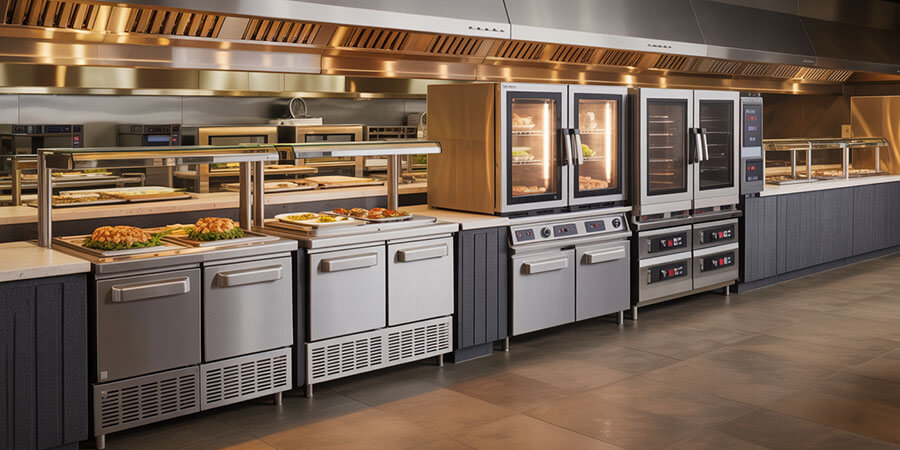
Table of Contents
Commercial Heated Holding Overview
Heated holding equipment maintains food at safe temperatures (135°F+) to prevent bacterial growth while preserving moisture and quality. From basic cabinets for buffet lines to advanced cook-and-hold systems and proofing units for bakery operations.
Types of Commercial Heated Holding Equipment
Commercial heated holding equipment encompasses several categories, each designed for specific food holding, merchandising, and preparation needs. The right choice depends on your operation type, menu complexity, and space constraints.
1. Heated Holding Cabinets
Heated holding cabinets maintain cooked food at safe serving temperatures (135°F minimum) while preserving moisture and quality. They are the foundation of most commercial heated holding setups.
Full-Height Holding Cabinets
Full-height holding cabinets offer maximum storage capacity with multiple shelves for high-volume operations requiring extended holding times.
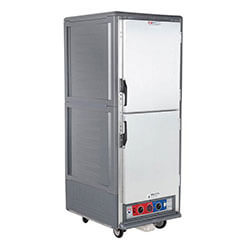
- Best Uses: Large restaurants, catering operations, hotels, institutional kitchens
- Capacities: 14-32 full-size pans, 17-32 hotel pans
- Features: Adjustable shelving, digital temperature controls, humidity options
- Temperature Range: 140-190°F with humidity control options
Half-Height Holding Cabinets
Half-height holding cabinets provide versatile storage in limited spaces, ideal for smaller operations or when floor space is at a premium.
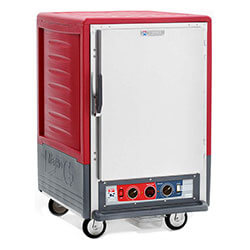
- Best Uses: Quick-service restaurants, cafes, satellite kitchens, smaller catering
- Capacities: 5-12 full-size pans, 8-17 hotel pans
- Features: Mobile options with casters, glass or solid doors, compact footprint
- Temperature Range: 140-180°F with consistent heat distribution
Pass-Through Holding Cabinets
Pass-through holding cabinets allow food loading from the back-of-house and retrieval from the front-of-house, streamlining workflow in busy operations.
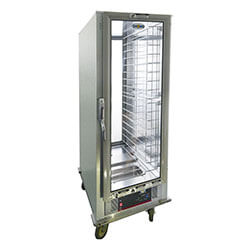
- Best Uses: High-volume restaurants, buffet lines, hotels with separate prep areas
- Capacities: 10-32 pans depending on configuration
- Features: Dual-access doors, seamless operation, enhanced safety
- Temperature Range: 140-190°F with independent controls
Roll-In Holding Cabinets
Roll-in holding cabinets accommodate mobile racks for large-scale operations, allowing entire batches to be loaded simultaneously.

- Best Uses: Large institutional kitchens, banquet facilities, high-volume caterers
- Features: Accepts standard roll-in racks, large capacity, efficient loading/unloading
- Temperature Range: 140-180°F with uniform heat distribution
2. Heated Merchandising Display Cases
Heated merchandising display cases combine holding functionality with attractive presentation, allowing customers to view and select hot food items.
Countertop Heated Display Cases
Countertop heated display cases provide visible merchandising in limited spaces, perfect for cafes, delis, and quick-service operations.

- Best Uses: Delis, cafes, convenience stores, small restaurants
- Features: Glass fronts, LED lighting, adjustable shelves, temperature controls
- Temperature Range: 140-160°F with humidity options
- Display Capacity: 3-6 pans or trays
Floor-Standing Heated Display Cases
Floor-standing heated display cases offer larger merchandising capacity with professional presentation for higher-volume operations.
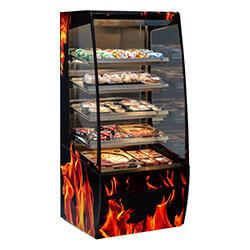
- Best Uses: Restaurants, caterers, grocery stores, food courts
- Features: Multiple shelves, glass doors, lighting, humidity control
- Temperature Range: 140-170°F with consistent heat
- Display Capacity: 8-20 pans depending on model
Self-Service Heated Merchandisers
Self-service heated merchandisers allow customers to access hot food directly, reducing labor while maintaining food safety and quality.
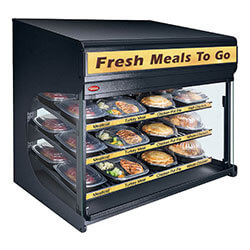
- Best Uses: Convenience stores, cafeterias, fast-casual restaurants
- Features: Sliding doors, portion control, automatic lighting, temperature monitoring
- Temperature Range: 140-160°F with safety features
- Capacity: Multiple compartments with individual controls
3. Cook-and-Hold Ovens
Cook-and-hold ovens combine cooking and holding functions, allowing food to be cooked to perfection then held at serving temperature without overcooking.
Countertop Cook-and-Hold Ovens
Countertop cook-and-hold ovens provide compact cooking and holding capability for limited-space operations.
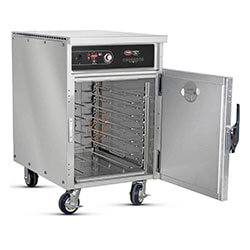
- Best Uses: Quick-service restaurants, cafes, small kitchens, satellite locations
- Features: Programmable controls, humidity injection, multiple cooking modes
- Capacity: 3-6 full-size pans
- Temperature Range: 140-350°F for cooking, 140-180°F for holding
Floor Cook-and-Hold Ovens
Floor cook-and-hold ovens offer larger capacity for medium to high-volume operations requiring both cooking and extended holding.
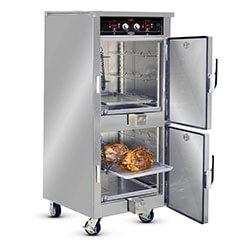
- Best Uses: Restaurants, caterers, institutional kitchens, hotels
- Features: Advanced programming, humidity control, multiple racks
- Capacity: 10-20 full-size pans
- Temperature Range: 140-400°F cooking, 140-190°F holding
4. Drawer Warmers
Drawer warmers provide convenient, organized storage for hot food items, allowing quick access and portion control.
Single Drawer Warmers
Single drawer warmers offer compact warming for specific menu items or limited-volume operations.

- Best Uses: Quick-service counters, cafes, small restaurants
- Features: Individual temperature controls, moisture retention, easy access
- Capacity: 1-2 full-size pans
- Temperature Range: 140-180°F with humidity options
Multiple Drawer Warmers
Multiple drawer warmers provide organized storage for various menu items, ideal for operations serving diverse hot foods.
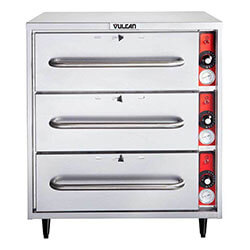
- Best Uses: Restaurants, delis, institutional cafeterias
- Features: Independent controls per drawer, stackable design, portion control
- Capacity: 2-6 drawers, each holding 1-2 pans
- Temperature Range: 140-190°F with consistent heat distribution
5. Chip and Snack Warmers
Specialized countertop warmers designed to keep chips, fries, and similar snacks crisp and fresh at serving temperature. All models are countertop units with capacities from 15-46 gallons.
Bulk Chip Warmers
Bulk chip warmers provide high-capacity storage for large quantities of chips, perfect for high-volume operations and concessions serving crowds.
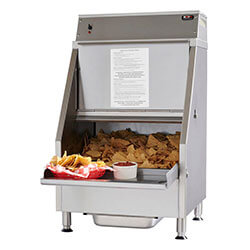
- Best Uses: Stadiums, arenas, large concessions, high-volume restaurants
- Features: Large capacity (25-46 gallons), forced-air heating, shatter-resistant design
- Capacity: 25-46 gallon models
- Temperature Range: 150-170°F with dry heat circulation
- Pros: High throughput, continuous service capability, cost-effective per chip
- Cons: Larger footprint, higher energy use
Chip Merchandisers
Chip merchandisers combine warming functionality with attractive display cases, featuring glass fronts and lighting to showcase chips and drive impulse sales.
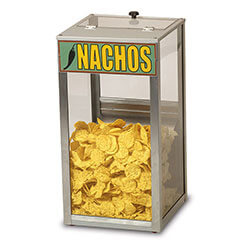
- Best Uses: Quick-service restaurants, convenience stores, movie theaters, bowling alleys
- Features: Glass fronts, LED lighting, portion control, merchandising display
- Capacity: 15-44 gallon models
- Temperature Range: 140-160°F with controlled humidity
- Pros: Visual merchandising, impulse sales increase, portion control
- Cons: Higher cost, requires counter space for display
6. Proofing Cabinets
Proofing cabinets create controlled environments for dough rising, maintaining optimal temperature and humidity for yeast activation.
Heated Proofing Cabinets
Heated proofing cabinets provide gentle warmth and humidity for optimal yeast activity in bread and dough production.

- Best Uses: Bakeries, restaurants with in-house bread programs, pizza operations
- Features: Adjustable humidity (60-95% RH), digital controls, adjustable shelving
- Capacity: 8-24 pans or trays
- Temperature Range: 70-115°F with precise humidity control
Refrigerated Dough Conditioning Cabinets
Refrigerated dough conditioning cabinets slowly ferment dough at controlled low temperatures for extended proofing times.

- Best Uses: Artisan bakeries, high-end restaurants, wholesale operations
- Features: Precise temperature control, extended fermentation times
- Capacity: 24-36 trays for bulk operations
- Temperature Range: 35-45°F for slow fermentation
7. Steam Tables & Food Wells
Steam tables and food wells provide wet-heat holding for prepared foods, using water baths to maintain safe serving temperatures.
Steam Tables
Steam tables feature built-in wells with constant water levels, ideal for buffet lines and high-volume service.
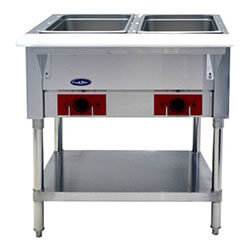
- Best Uses: Buffets, cafeterias, banquet halls, institutional settings
- Features: Built-in water pans, individual heat controls, seamless construction
- Capacity: 3-12 wells per unit, each holding multiple pans
- Temperature Range: 140-190°F with consistent water bath heating
Drop-In Food Hot Wells
Drop-in hot food wells install into existing counters, providing flexible heated holding capacity.
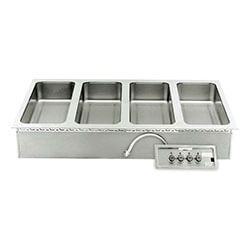
- Best Uses: Existing service lines, retrofitting older operations, modular setups
- Features: Countertop installation, independent heating, easy maintenance
- Capacity: 1-4 wells per unit
- Temperature Range: 140-180°F with adjustable controls
Heat Lamps & Strip Warmers
Overhead warming equipment provides targeted heat for pass-through areas and service counters.
Heat Lamps
Heat lamps for food use infrared bulbs to maintain food temperatures in high-traffic areas.
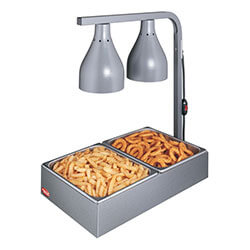
- Best Uses: Pass-through windows, service counters, pickup stations
- Features: Adjustable height, energy-efficient bulbs, focused heating
- Capacity: Covers 2-6 foot service areas
- Temperature Range: 140-180°F with adjustable intensity
Strip Warmers
Strip warmers for food provide continuous overhead heat along service lines and prep areas.

- Best Uses: Buffet lines, salad bars, condiment stations, steam table extensions
- Features: Continuous heating elements, even heat distribution, low-profile design
- Capacity: 18-72 inch lengths
- Temperature Range: 140-170°F with thermostat control
8. Countertop Food Warmers
Compact countertop units provide additional heated holding capacity for smaller operations.
Countertop Buffet Warmers
Countertop buffet warmers offer versatile heated holding in limited spaces.

- Best Uses: Small cafes, quick-service operations, satellite kitchens
- Features: Multiple compartments, adjustable shelves, compact footprint
- Capacity: 3-6 pans
- Temperature Range: 140-180°F with humidity options
Countertop Soup Kettles & Warmers
Specialized warmers for soups, stews, and sauces with ladle access.
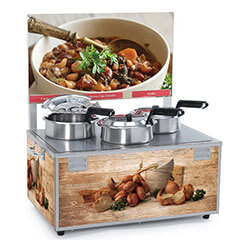
- Best Uses: Soup stations, sauce service, beverage operations
- Features: Hinged lids, ladle-friendly design, temperature control
- Capacity: 3-20 gallons
- Temperature Range: 140-190°F with stirring options
9. Heated Display Warmers & Cases
Enhanced merchandising units combine holding functionality with attractive product presentation.
Countertop Pizza Warmers & Merchandisers
Specialized warmers designed to hold and display pizza while maintaining crisp crust.
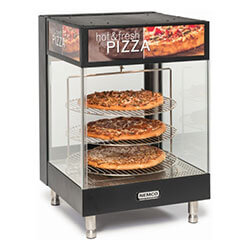
- Best Uses: Pizzerias, quick-service restaurants, convenience stores
- Features: Glass doors, interior lighting, humidity control for crust
- Capacity: 4-12 pizzas
- Temperature Range: 140-170°F with specialized pizza settings
Pretzel Warmers & Merchandisers
Dedicated warmers for pretzels and similar baked goods with merchandising features.
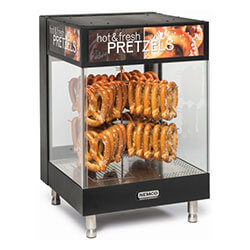
- Best Uses: Pretzel shops, sports venues, convenience stores
- Features: Glass display, humidity control, attractive presentation
- Capacity: 20-50 pretzels
- Temperature Range: 140-160°F with moisture retention
Brand Landscape
Leading brands offer different strengths for heated holding equipment, with varying focuses on capacity, technology, and specialized applications.
- FWE - High-capacity solutions with excellent merchandising features, ideal for large operations needing both holding and display capabilities
- Hatco - Specialized warming solutions with advanced humidity control, perfect for moisture-sensitive foods and premium presentations
- Winston - Superior moisture retention technology and precise temperature control, best for quality-focused operations
- Carter-Hoffmann - Robust construction with comprehensive holding solutions, reliable for high-volume restaurant and institutional use
- Metro - Flexible configurations and excellent insulation, good value for diverse operational needs
- Vulcan - Commercial-grade durability with consistent performance, trusted by large foodservice operations
- Doyon - Advanced proofing and baking technology, specialized for operations with extensive bakery programs
Key Features & Technologies
Commercial heated holding equipment includes advanced features that ensure food safety, quality preservation, and operational efficiency.
Temperature & Humidity Control
Precise control systems maintain optimal conditions for different food types.
- Digital Controls: LCD displays with programmable settings and alarms
- Temperature Monitoring: Probe ports and alarms for HACCP compliance
- Humidity Systems: Water reservoirs and injection systems for moisture retention
- Programmable Timers: Automatic shutoff and temperature adjustment schedules
Capacity & Configuration
Flexible storage options accommodate various pan sizes and operational needs.
- Adjustable Shelving: Accommodates different pan heights (2.5"-6" spacing)
- Universal Slides: Accept both 18x26 and 12x20 pans
- Roll-In Compatibility: Accepts standard mobile racks
- Stackable Designs: Multiple units for expanded capacity
Safety & Compliance Features
Built-in safety systems protect both food and staff.
- Temperature Alarms: Alert when temperatures fall below safe levels (135°F)
- Door Locks: Prevent unauthorized access in commercial environments
- Cool-Touch Handles: Reduce burn risk for staff
- NSF Certification: Meets foodservice safety and sanitation standards
Energy Efficiency Features
Advanced designs reduce operating costs while maintaining performance.
- Insulated Construction: Reduces energy consumption and heat loss
- Programmable Controls: Energy-saving modes and automatic shutoff
- High-Efficiency Heating: Optimized heating elements for faster recovery
- LED Lighting: Energy-efficient interior and display lighting
Mobility & Installation
Flexible designs accommodate different kitchen layouts and operational needs.
- Caster Options: Easy mobility for repositioning or cleaning
- Stackable Units: Vertical space optimization
- Pass-Through Designs: Improved workflow in busy operations
- Countertop Models: Space-saving solutions for limited areas
Equipment Comparison Table
| Equipment Type: | Capacity: | Temperature Range: | Best For: | Key Features: | Price Range: |
| Holding Cabinets | 5-32 pans | 135-190°F | Restaurants, caterers | Humidity control, adjustable shelving | $2,000-6,000 |
| Cook-and-Hold Ovens | 3-24 pans | 140-400°F | High-volume kitchens | Programmable cooking, humidity injection | $3,000-8,000 |
| Steam Tables | 3-12 wells | 135-190°F | Buffets, cafeterias | Water bath heating, built-in wells | $800-3,500 |
| Heat Lamps | 2-6 ft areas | 135-180°F | Pass-through, counters | Infrared bulbs, adjustable height | $100-400 |
| Strip Warmers | 18-72 inches | 135-170°F | Buffet lines, counters | Continuous heating, thermostat | $200-800 |
| Heated Merchandisers | 3-20 pans | 135-170°F | Quick-service, delis | Glass display, LED lighting | $4,000-12,000 |
| Drawer Warmers | 1-6 drawers | 135-190°F | Restaurants, delis | Individual controls, portion access | $500-2,000 |
| Countertop Buffet Warmers | 3-6 pans | 135-180°F | Small cafes, QSR | Compact footprint, multiple compartments | $300-1,200 |
| Pizza Warmers | 4-12 pizzas | 135-170°F | Pizzerias, QSR | Glass doors, crust preservation | $1,500-4,500 |
| Bulk Chip Warmers | 25-46 gallons | 150-170°F | Stadiums, concessions | High capacity, forced air | $3,000-5,000 |
| Chip Merchandisers | 15-44 gallons | 135-160°F | QSR, convenience stores | Display cases, merchandising | $4,000-7,000 |
| Proofing Cabinets | 8-36 trays | 70-115°F | Bakeries, restaurants | Humidity control, adjustable racks | $2,500-7,000 |
Selecting Commercial Heated Holding Equipment
Choosing the right heated holding equipment requires careful consideration of your operation's specific needs, from food volume and type to available space and budget.
Operation Type & Volume
Match equipment to your daily production and service requirements.
- Low Volume (Cafes/Small Restaurants): Countertop warmers, single drawer warmers (1-5 pans daily)
- Medium Volume (Family Restaurants): Half-height cabinets, cook-and-hold ovens (5-15 pans daily)
- High Volume (Large Restaurants/Catering): Full-height cabinets, roll-in systems (15-50+ pans daily)
- Institutional: Multiple units, pass-through designs, bulk capacity
Food Type Considerations
Different foods require specific holding environments for optimal quality.
- Moist Foods: Require humidity control (vegetables, rice, sauces)
- Crispy Foods: Need dry heat (fried items, pizza, breaded products)
- Complex Menus: Multiple units or zoned equipment for different requirements
- Display Needs: Heated merchandisers for customer-facing operations
Space & Installation Requirements
Consider physical constraints and workflow integration.
- Counter Space: Countertop models for limited prep areas
- Floor Space: Full-height units (24-30" wide) vs. compact options
- Height Requirements: Standard units (60-80") vs. undercounter options
- Electrical Capacity: Verify circuit requirements (15-50 amp circuits)
Temperature Control Needs
Advanced controls provide better food quality and compliance.
- Basic Operations: Standard digital controls with manual settings
- Quality-Focused: Programmable controls with humidity management
- Compliance-Heavy: HACCP-ready systems with logging capabilities
- Multi-Zone: Equipment with independent temperature zones
Budget & Operating Costs
Balance upfront investment with long-term operating expenses.
- Entry-Level: $500-2,000 for basic countertop warmers
- Mid-Range: $2,000-5,000 for cabinets and cook-and-hold ovens
- Premium: $5,000-10,000+ for advanced merchandisers and proofing systems
- Energy Costs: $3-15 daily depending on size and usage
Quick Selection Checklist:
- Daily food volume and holding requirements?
- Food types (moist vs. crispy, display needs)?
- Available space and electrical capacity?
- Budget and energy cost considerations?
- Need for merchandising or just basic holding?
Installation & Maintenance
Proper installation and regular maintenance ensure optimal performance and food safety.
Installation Guidelines
Professional installation prevents operational issues and ensures safety.
- Location Requirements: Level surface, adequate ventilation, proper clearances (6" from walls)
- Electrical Connections: Dedicated circuits, proper grounding, surge protection
- Door Adjustments: Ensure proper seal and alignment for energy efficiency
- Initial Calibration: Set temperatures and test humidity systems before use
Operating Procedures
Proper use extends equipment life and maintains food quality.
- Preheating: Allow 30-60 minutes for temperature stabilization
- Loading Practices: Avoid overloading, maintain proper spacing, use appropriate pans
- Temperature Monitoring: Regular checks with probe thermometers, HACCP compliance
- Cleaning Schedule: Daily wipe-down, weekly deep cleaning, monthly part inspection
Maintenance Tasks
Regular maintenance prevents breakdowns and ensures consistent performance.
Daily:
- Clean surfaces and remove food debris
- Check temperature readings and alarms
- Inspect door seals and gaskets
- Verify humidity levels if applicable
Weekly:
- Deep clean heating elements and coils
- Calibrate temperature controls
- Clean water reservoirs and humidity systems
- Check and clean air filters
Monthly:
- Lubricate moving parts and hinges
- Inspect electrical components and connections
- Replace air filters if applicable
- Test safety features and alarms
Annually:
- Schedule professional servicing
- Replace worn parts and gasket
- Update firmware and software
- Calibrate all sensors and controls
Troubleshooting Common Issues
Address problems quickly to maintain service quality.
- Temperature Fluctuations: Check insulation, calibrate controls, ensure proper loading
- Excessive Moisture: Adjust humidity settings, improve drainage
- Energy Consumption: Inspect insulation, clean heating elements, verify settings
- Door Seal Issues: Replace worn gaskets, adjust door alignment
Costs & ROI Analysis
Understanding the financial aspects helps justify heated holding equipment investments.
Initial Investment Ranges
Purchase prices vary based on type, capacity, and features.
- Entry-Level: $100-800 for heat lamps, strip warmers, and basic countertop warmers
- Mid-Range: $800-3,500 for steam tables, drawer warmers, and countertop buffet warmers
- Professional: $2,000-6,000 for holding cabinets and cook-and-hold ovens
- Premium: $4,000-12,000 for heated merchandisers, pizza warmers, and chip merchandisers
- Specialized: $2,500-7,000 for proofing cabinets and bakery-specific equipment
Operating Cost Factors
Energy consumption and maintenance affect long-term expenses.
- Energy Use: 500W-3kW depending on equipment type and size
- Typical Daily Cost: $2-12 per unit at commercial rates
- Maintenance Costs: $200-500 annually for cleaning and minor repairs
- Replacement Parts: $100-800 for common components
Return on Investment Benefits
Quality equipment provides multiple financial advantages.
- Reduced Food Waste: Extended holding times minimize waste (15-30% savings)
- Improved Efficiency: Batch cooking and holding reduces labor costs
- Enhanced Service: Consistent food quality improves customer satisfaction
- Merchandising Value: Display cases increase impulse sales
Warranty & Support
Warranty coverage varies by manufacturer and equipment type.
- Standard Warranty: 1-3 years parts and labor
- Extended Coverage: Optional plans for additional protection
- Technical Support: Most brands offer phone/email assistance
- Parts Availability: Easy access to replacement components
Frequently Asked Questions
What's the difference between heated holding cabinets and cook-and-hold ovens?
Holding cabinets maintain already cooked food at safe temperatures (135°F+), while cook-and-hold ovens can finish cooking or holding. Cook-and-hold units offer more versatility for complex menu items requiring both functions.
Do I need humidified or dry heated holding equipment?
Use humidified for moist foods (vegetables, rice, sauces) and dry heat for crispy items (fried foods, pizza, baked goods). Some equipment offers both options for maximum flexibility.
How long can food safely be held in heated equipment?
Hot food can be held safely for 2-4 hours at 135°F+. Advanced systems with better humidity control can extend this to 6-8 hours. Always monitor temperatures and follow HACCP guidelines.
What's the best heated holding equipment for a buffet operation?
Pass-through holding cabinets with humidity control work best for buffets, allowing back-of-house loading and front-of-house service while maintaining food quality and safety.
Can heated merchandisers increase sales?
Yes, heated display cases with glass fronts and LED lighting can increase impulse purchases by 20-40% by making hot foods more visible and appealing to customers.
Do proofing cabinets speed up bread making?
Proofing cabinets don't necessarily speed up the process but provide precise temperature and humidity control, resulting in more consistent quality and allowing for larger batch production.
What's the energy cost of heated holding equipment?
Average 1-3 kW usage. A full holding cabinet costs $3-10 daily to operate. Look for insulated models and programmable controls to reduce energy consumption by 20-30%.
How do I choose between countertop and floor models?
Countertop models save floor space but have limited capacity. Floor models offer more storage but require floor space. Consider your daily volume and available space.
Are heated holding cabinets NSF certified?
Most commercial models are NSF certified for food equipment. Always verify certification and check local health department requirements.
What's the payback period for heated holding equipment?
Typically 6-18 months through reduced waste, improved efficiency, and increased sales. Premium merchandisers may pay back in 12-24 months through display-driven sales increases.
Related Equipment
Complete your food service setup with these complementary heating and holding solutions.
- [Cook & Hold Ovens] - Advanced cooking and holding systems.
- [Food Holding & Warming Equipment] - Complete range of holding solutions.
- [Steam Tables & Food Wells] - Wet holding alternatives for buffet service.
- [Heated Display Warmers & Cases] - Merchandising solutions with presentation.
- [Heat Lamps] -
- [Strip Warmers] - Overhead warming for service areas.
- [Commercial Refrigeration] - Cold holding for comprehensive food management.
Need help selecting the right heated holding equipment? Contact our foodservice specialists for personalized recommendations based on your menu volume, space constraints, and budget.
Share This!